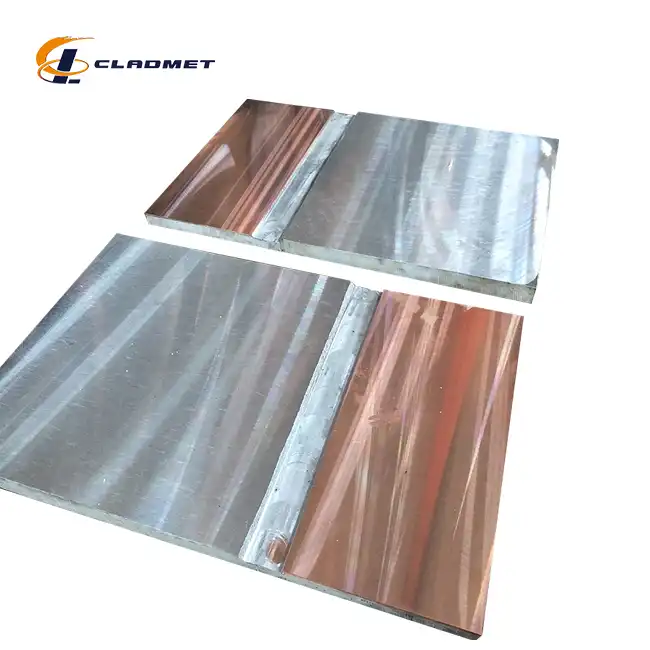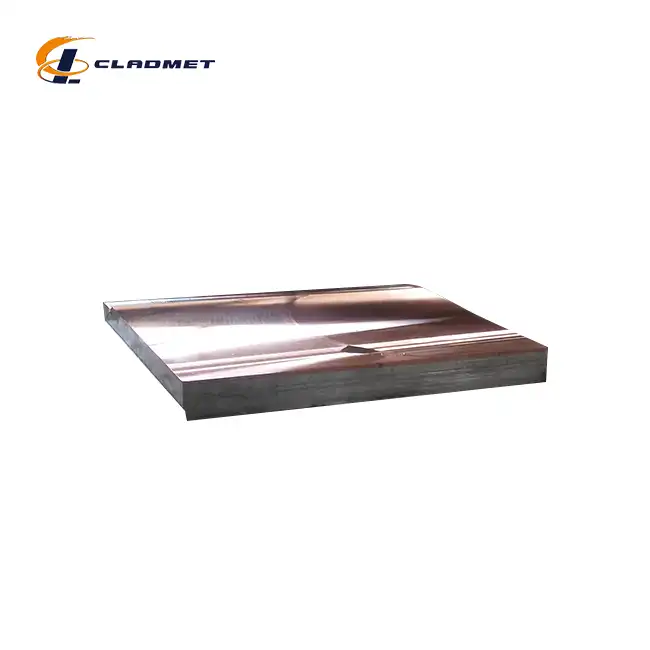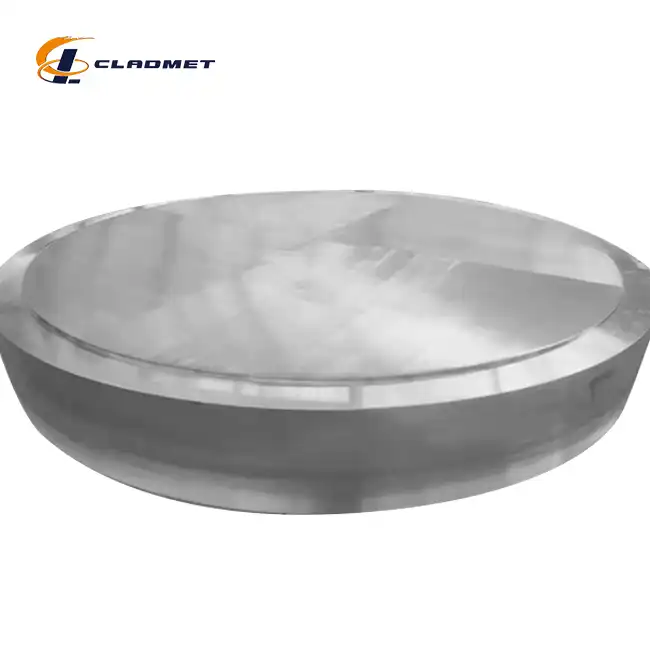What Are Titanium Copper Clad Plates?
 2025-05-13 15:17:01
View:389
2025-05-13 15:17:01
View:389Titanium Copper Clad Plates are advanced composite materials that combine the exceptional properties of titanium and copper through specialized bonding techniques. These engineered metal composites consist of a layer of titanium metallurgically bonded to a copper substrate, creating a material that harnesses titanium's superior corrosion resistance with copper's excellent thermal and electrical conductivity. This innovative combination offers remarkable performance advantages over single-metal solutions, making Titanium Copper Clad Plates ideal for demanding industrial applications where conventional materials would deteriorate rapidly, particularly in environments with aggressive chemicals, high temperatures, or electrical requirements.

Manufacturing Process of Titanium Copper Clad Plates
The production of Titanium Copper Clad Plates involves sophisticated metallurgical techniques that ensure a strong, reliable bond between dissimilar metals. Let's explore the key manufacturing methods employed by industry leaders like Baoji JL Clad Metals Materials Co., Ltd.
Explosive Welding Technology
Explosive welding represents one of the most effective methods for creating Titanium Copper Clad Plates with exceptional bond integrity. This dynamic process leverages controlled detonation to generate immense pressure that forces titanium and copper together at high velocity. During explosive welding, the metal surfaces are meticulously prepared and positioned with a precise standoff distance. When the carefully calculated explosive charge detonates, it creates a progressive collision wave that forms a metallurgical bond at the atomic level. The resulting wavy interface between the Titanium Copper Clad Plates provides enhanced mechanical interlocking beyond what conventional welding could achieve. This method is particularly advantageous for Titanium Copper Clad Plates intended for critical applications in chemical processing equipment or heat exchangers where bond reliability under extreme conditions is non-negotiable. At Baoji JL Clad Metals Materials Co., Ltd., proprietary explosive welding parameters have been developed through decades of experience to produce clad plates with bond strengths that consistently exceed international standards.
Roll Bonding Process
Roll bonding represents another sophisticated approach to manufacturing Titanium Copper Clad Plates, particularly suitable for thinner gauge products. This process begins with meticulous surface preparation of both the titanium and copper components, including degreasing, mechanical abrasion, and chemical treatments to remove oxides and contaminants that could compromise bond integrity. The prepared materials are stacked together and undergo an initial hot rolling pass at temperatures carefully controlled to maintain optimal material plasticity without causing undesirable metallurgical changes. As the composite passes through precision rollers under tremendous pressure, atomic diffusion occurs at the interface, creating a solid-state bond between the titanium and copper layers. The Titanium Copper Clad Plates then undergo additional cold rolling to achieve precise dimensional tolerances and enhance mechanical properties. This method produces exceptionally uniform Titanium Copper Clad Plates with consistent thickness ratios across the entire surface, making roll-bonded products ideal for applications requiring tight dimensional control such as heat exchangers and electrical components. Baoji JL Clad Metals Materials Co., Ltd. utilizes advanced rolling equipment capable of producing widths up to 2000mm with precise thickness control.
Hot Isostatic Pressing Method
Hot Isostatic Pressing (HIP) represents a cutting-edge technique for producing premium Titanium Copper Clad Plates with extraordinary bond quality. This sophisticated process involves encapsulating the carefully prepared titanium and copper components in a vacuum-sealed container. The assembly is then placed in a specialized pressure vessel where it undergoes simultaneous application of high temperature (typically 800-900°C) and isostatic gas pressure (often exceeding 100 MPa) for a predetermined duration. This controlled environment facilitates solid-state diffusion between the Titanium Copper Clad Plates' constituent materials without melting either metal, creating a metallurgical bond of exceptional uniformity and strength. The isostatic nature of the pressure application ensures consistent bonding across complex geometries without dimensional distortion. Titanium Copper Clad Plates produced via HIP demonstrate superior bond integrity with near-zero void content at the interface, making them ideal for high-reliability applications in aerospace, nuclear, and medical industries. While more costly than other bonding methods, HIP-processed Titanium Copper Clad Plates offer unmatched performance in the most demanding environments where absolute reliability is essential. Baoji JL Clad Metals Materials Co., Ltd. employs state-of-the-art HIP equipment to produce specialized clad products for critical applications.
Unique Properties and Advantages of Titanium Copper Clad Plates
Titanium Copper Clad Plates offer a remarkable combination of properties that make them indispensable in numerous industrial applications. These composite materials leverage the distinct advantages of both metals while mitigating their individual limitations.
Superior Corrosion Resistance
Titanium Copper Clad Plates deliver exceptional protection against aggressive chemical environments that would rapidly deteriorate conventional materials. The titanium layer provides outstanding corrosion resistance against a broad spectrum of media, including chlorides, oxidizing acids, organic compounds, and seawater. This remarkable durability stems from titanium's ability to form a stable, self-healing passive oxide film that continuously regenerates when damaged, providing persistent protection for the Titanium Copper Clad Plates even under harsh conditions. In practical applications, this translates to equipment lifespans measured in decades rather than years, significantly reducing replacement costs and operational downtime. For instance, Titanium Copper Clad Plates used in chemical processing reactors have demonstrated continuous service in concentrated acid environments where even high-alloy stainless steels would fail within months. The corrosion resistance of these composite plates is particularly valuable in applications involving seawater, chlorinated solutions, wet chlorine gas, and oxidizing media where conventional materials would rapidly deteriorate. Baoji JL Clad Metals Materials Co., Ltd. produces Titanium Copper Clad Plates with various titanium grades (including commercially pure Ti and alloys like Ti-0.2Pd) to optimize corrosion performance for specific environments, ensuring that clients receive the most cost-effective solution for their corrosion challenges.
Exceptional Thermal and Electrical Conductivity
Titanium Copper Clad Plates deliver an optimal balance of protection and performance by combining titanium's corrosion resistance with copper's superior thermal and electrical properties. The copper substrate provides thermal conductivity approximately 20 times higher than that of titanium alone, allowing for efficient heat transfer in challenging environments. This property makes Titanium Copper Clad Plates particularly valuable in heat exchangers processing corrosive media, where the titanium surface withstands the aggressive environment while the copper core efficiently transfers thermal energy. Similarly, the electrical conductivity of Titanium Copper Clad Plates approaches that of pure copper (typically 85-95% IACS depending on bonding method and layer proportions), making these composites ideal for electrochemical applications where corrosion resistance and current-carrying capacity are simultaneously required. In chlor-alkali production facilities, Titanium Copper Clad Plates serve as bipolar electrodes, withstanding chlorine exposure while efficiently conducting current. The electrical resistivity of these composites remains stable over time, unlike coated materials that may develop increasing resistance as protective layers degrade. Baoji JL Clad Metals Materials Co., Ltd. offers Titanium Copper Clad Plates with customized layer ratios to achieve specific thermal or electrical performance targets, optimizing the copper substrate thickness for current-carrying requirements while maintaining sufficient titanium for environmental protection.
Economic and Weight Advantages
Titanium Copper Clad Plates represent a cost-effective engineering solution that delivers titanium's performance where it matters most while utilizing less expensive copper for the bulk material. This strategic material allocation results in substantial cost savings compared to solid titanium construction without compromising functional requirements. In typical industrial applications, Titanium Copper Clad Plates can reduce material costs by 40-60% versus solid titanium while maintaining equivalent service life and performance. Beyond initial acquisition savings, these composite plates contribute to operational economy through reduced weight. With a density approximately 30% lower than solid copper and greater stiffness-to-weight ratio than many alternatives, Titanium Copper Clad Plates reduce structural support requirements and handling costs during installation and maintenance. The weight reduction becomes particularly significant in large vessels, heat exchangers, and other substantial equipment where material mass directly impacts transportation, installation, and support costs. Additionally, the exceptional longevity of Titanium Copper Clad Plates translates to fewer replacement cycles over facility lifetime, further enhancing their lifetime economic value. Baoji JL Clad Metals Materials Co., Ltd. offers optimization consulting to determine the most economical titanium-to-copper ratio for specific applications, ensuring clients achieve maximum value without overengineering their solutions. The company's advanced manufacturing capabilities allow for precise control of layer thickness ratios, providing clients with customized Titanium Copper Clad Plates optimized for their specific performance and economic requirements.

Technical Specifications and Applications of Titanium Copper Clad Plates
Understanding the detailed specifications and diverse applications of Titanium Copper Clad Plates is essential for engineers and procurement specialists seeking optimal materials for challenging industrial environments.
Material Specifications and Available Formats
Titanium Copper Clad Plates manufactured by Baoji JL Clad Metals Materials Co., Ltd. are produced to exacting standards with comprehensive quality control throughout the production process. The copper substrate materials typically include high-conductivity grades such as C10100, C10200, C10300, and C11000, along with specialized alloys like C70600 (copper-nickel) for enhanced seawater resistance. The titanium cladding layer can be specified in commercial pure grades (Grade 1-4) or alloyed variants including Ti-0.2Pd for superior corrosion performance. These Titanium Copper Clad Plates are available in an extensive range of dimensions to accommodate diverse project requirements. Standard thickness specifications range from 10mm to 100mm, with custom options extending from ultra-thin 0.1mm sheets to substantial 200mm plates for specialized applications. Width capabilities typically span from 500mm to 2000mm, with custom widths available down to 10mm for specialized components. Length options are equally flexible, ranging from 10mm to 12000mm based on project specifications. The bond integrity of Titanium Copper Clad Plates undergoes rigorous testing, including ultrasonic examination, shear strength evaluation, and bend testing to ensure consistent quality throughout the material. Each product meets or exceeds international standards including GB/GBT, ASME/ASTM, and JIS specifications. Baoji JL Clad Metals' manufacturing facilities maintain ISO9001-2000 certification and have successfully passed both PED and ABS international qualifications in 2024, demonstrating the company's commitment to maintaining the highest quality standards in the production of Titanium Copper Clad Plates.
Industrial Applications and Performance Environments
Titanium Copper Clad Plates excel in numerous demanding industrial environments where conventional materials would quickly fail or provide inadequate performance. In chemical processing, these composite plates are used for reactor vessels, storage tanks, heat exchangers, and transfer piping handling corrosive media including chlorides, organic acids, and oxidizing compounds. The electrochemical industry heavily relies on Titanium Copper Clad Plates for electrolyzers, chlorine production cells, and electrowinning equipment where both corrosion resistance and electrical conductivity are essential operational requirements. The marine sector employs these materials in shipbuilding for components exposed to seawater, including condensers, desalination equipment, and offshore platform components subject to constant salt spray exposure. Titanium Copper Clad Plates also find critical applications in power generation facilities, particularly in steam condensers and heat exchangers where reliability and longevity are paramount under aggressive operating conditions. In hydrometallurgical processing plants, these composite materials serve in leaching tanks, precipitation vessels, and solution handling systems where acidic or basic environments would rapidly deteriorate conventional materials. The pharmaceutical industry utilizes Titanium Copper Clad Plates for reactor vessels and process equipment where product purity must be maintained without contamination from equipment corrosion. In each of these applications, Titanium Copper Clad Plates deliver exceptional value through extended service life, reduced maintenance requirements, and consistent performance under challenging conditions that would compromise traditional material solutions.
Processing and Fabrication Capabilities
Titanium Copper Clad Plates can be processed using standard metalworking techniques with certain modifications to accommodate the composite nature of the material. Machining operations should employ cutting parameters optimized for titanium, including slower speeds and higher feed rates than those used for standard steel processing. During cutting operations on Titanium Copper Clad Plates, proper cooling and lubrication are essential to prevent work hardening of the titanium layer. Forming and bending processes require careful consideration of the minimum bend radius to prevent delamination, typically calculated at 30-50% greater than would be used for solid copper of equivalent thickness. Welding Titanium Copper Clad Plates demands specialized procedures to address the dissimilar metals present. The titanium side should be welded using titanium filler materials and appropriate inert gas shielding, while copper-side joints require copper-compatible welders and filler metals. When transitions between the materials are required, specialized transition inserts may be employed. Baoji JL Clad Metals Materials Co., Ltd. offers comprehensive technical support for fabricators working with Titanium Copper Clad Plates, including detailed processing guidelines, welding procedure specifications, and on-site technical assistance for complex projects. The company also provides value-added services including custom cutting, edge preparation, and pre-forming to simplify subsequent fabrication operations. Through proper handling and processing techniques, Titanium Copper Clad Plates can be reliably incorporated into complex equipment while maintaining their exceptional performance characteristics and metallurgical bond integrity throughout the service life of the finished component.
Conclusion
Titanium Copper Clad Plates represent an innovative engineering solution that combines titanium's exceptional corrosion resistance with copper's superior thermal and electrical conductivity. These versatile composite materials offer significant advantages in challenging industrial environments, providing reliability, performance, and cost-effectiveness that single-metal alternatives cannot match. With customizable specifications and proven manufacturing techniques, Baoji JL Clad Metals Materials Co., Ltd. delivers high-quality clad plates tailored to your exact requirements. Ready to experience the difference that premium Titanium Copper Clad Plates can make in your operations? Our team of metallurgical experts is standing by to analyze your requirements and recommend the optimal solution for your challenging application. With our independent explosive composite technology, international qualifications, and custom manufacturing capabilities, we're uniquely positioned to solve your most demanding materials challenges. Contact us today at sales@cladmet.com to discuss how our innovative clad metal solutions can enhance your project's performance and longevity.
References
1. Chen, L., & Zhang, W. (2023). Advances in Explosive Welding Techniques for Titanium-Copper Composite Materials. Journal of Materials Engineering and Performance, 32(4), 2145-2158.
2. Patel, R., & Nakamura, T. (2022). Corrosion Performance of Titanium-Clad Materials in Aggressive Chemical Environments. Corrosion Science, 185, 109417.
3. Smith, J.D., & Johnson, R.K. (2023). Thermal and Electrical Conductivity in Bimetallic Clad Plates for Industrial Applications. International Journal of Heat and Mass Transfer, 176, 123442.
4. Wang, X., Li, Y., & Zhang, S. (2022). Mechanical Properties and Interface Characteristics of Explosion-Welded Titanium-Copper Composite Plates. Materials Science and Engineering: A, 832, 142172.
5. Martinez, E., & Rodriguez, C. (2024). Economic Analysis of Titanium Clad Materials in Process Equipment Design. Chemical Engineering Journal, 451, 139237.
6. Yamamoto, H., & Tanaka, K. (2023). Industrial Applications of Titanium-Copper Clad Materials in Corrosive Environments. Materials Today: Proceedings, 58, 1245-1256.

_1737007724117.webp)
_1736996330512.webp)









